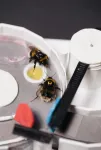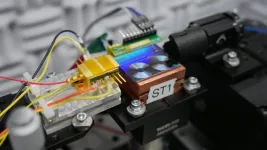(Press-News.org) ITHACA, N.Y. – Cornell University researchers have developed a semiconductor chip that will enable ever-smaller devices to operate at the higher frequencies needed for future 6G communication technology.
The next generation of wireless communication not only requires greater bandwidth at higher frequencies – it also needs a little extra time. The new chip adds a necessary time delay so signals sent across multiple arrays can align at a single point in space-- without disintegrating.
The team’s paper, “Ultra-Compact Quasi-True-Time-Delay for Boosting Wireless Channel-Capacity,” published March 6 in Nature. The lead author is Bal Govind, a doctoral student in electrical and computer engineering.
The majority of current wireless communications, such as 5G phones, operate at frequencies below 6 gigahertz (GHz). Technology companies have been aiming to develop a new wave of 6G cellular communications that use frequencies above 20 GHz, where there is more available bandwidth, which means more data can flow and at a faster rate. 6G is expected to be 100 times faster than 5G.
However, since data loss through the environment is greater at higher frequencies, one crucial factor is how the data is relayed. Instead of relying on a single transmitter and a single receiver, most 5G and 6G technologies use a more energy-efficient method: a series of phased arrays of transmitters and receivers.
“Every frequency in the communication band goes through different time delays,” Govind said. “The problem we’re addressing is decades old – that of transmitting high-bandwidth data in an economical manner so signals of all frequencies line up at the right place and time.”
“It’s not just building something with enough delay, it’s building something with enough delay where you still have a signal at the end,” said senior author Alyssa Apsel, professor of engineering. “The trick is that we were able to do it without enormous loss.”
Bal worked with postdoctoral researcher and co-author Thomas Tapen to design a complementary metal-oxide-semiconductor (CMOS) that could tune a time delay over an ultra-broad bandwidth of 14 GHz, with as high as 1 degree of phase resolution
“Since the aim of our design was to pack as many of these delay elements as possible,” Govind said, “we imagined what it would be like to wind the path of the signal in three-dimensional waveguides and bounce signals off of them to cause delay, instead of laterally spreading wavelength-long wires across the chip.”
The team engineered a series of these 3D reflectors strung together to form a “tunable transmission line.”
The resulting integrated circuit occupies a 0.13-square-millimeter footprint that is smaller than phase shifters yet nearly doubles the channel-capacity – i.e., data rate – of conventional wireless arrays. And by boosting the projected data rate, the chip could provide faster service, getting more data to cellphone users.
“The big problem with phased arrays is this tradeoff between trying to make these things small enough to put on a chip and maintain efficiency,” Apsel said. “The answer that most of the industry has landed on is, ‘Well, we can’t do time delay, so we’re going to do phase delay.’ And that fundamentally limits how much information you can transmit and receive. They just sort of take that hit.
“I think one of our major innovations is really the question: Do you need to build it this way?” Apsel said. “If we can boost the channel capacity by a factor of 10 by changing one component, that is a pretty interesting game-changer for communications.”
Cornell University has dedicated television and audio studios available for media interviews.
-30-
END
3D reflector microchips could speed development of 6G wireless
2024-03-06
ELSE PRESS RELEASES FROM THIS DATE:
Adverse childhood experiences and adult mental health outcomes
2024-03-06
About The Study: The results of this study using twin data support an association between adverse childhood experiences and poor mental health in adulthood, notwithstanding evidence for familial confounding from shared genetic and environmental factors. These findings suggest that targeted interventions may be associated with reduced risks of future psychopathology.
Authors: Hilda Björk Daníelsdóttir, M.Sc., of the University of Iceland in Reykjavík, Iceland, is the corresponding author.
To access the embargoed ...
Symptoms of cognitive impairment among children with atopic dermatitis
2024-03-06
About The Study: The findings of this study suggest that pediatric atopic dermatitis (AD) was generally associated with greater odds of reported difficulties in learning and memory. However, this association was primarily limited to children with neurodevelopmental comorbidities, such as attention-deficit/hyperactivity disorder or learning disabilities. These results may improve the risk stratification of children with AD for cognitive impairments and suggest that evaluation for cognitive difficulties should be prioritized among children with AD and neurodevelopmental disorders.
Authors: Joy ...
Charge fractionalisation observed spectroscopically
2024-03-06
A research team led by the Paul Scherrer Institute has spectroscopically observed fractionalisation of electronic charge in an iron-based metallic ferromagnet. Experimental observation of the phenomenon is not only of fundamental importance. Since it appears in an alloy of common metals at accessible temperatures, it holds potential for future exploitation in electronic devices. The discovery is published in the journal Nature.
Basic quantum mechanics tells us that the fundamental unit of charge is unbreakable: the electron charge is quantised. Yet, we have come to understand that exceptions exist. In some situations, ...
Bee-2-Bee influencing: Bees master complex tasks through social interaction
2024-03-06
In a groundbreaking discovery, bumblebees have been shown to possess a previously unseen level of cognitive sophistication. A new study, published in Nature, reveals that these fuzzy pollinators can learn complex, multi-step tasks through social interaction, even if they cannot figure them out on their own. This challenges the long-held belief that such advanced social learning is unique to humans, and even hints at the presence of key elements of cumulative culture in these insects.
Led by Dr Alice Bridges and Professor Lars Chittka , the research team designed a two-step puzzle box requiring ...
New study may broaden the picture of the consequences of childhood adversity
2024-03-06
A research team has examined the link between adverse childhood experiences and the risk of mental health problems later in life, according to a study in JAMA Psychiatry. The researchers from Karolinska Institutet and University of Iceland have found that the risk of suffering from mental illness later in life among those experiencing significant adversity in childhood can be partly explained by factors shared by family members, such as genetics and environment.
Several previous studies have shown that people who have experienced ...
Revealing the evolutionary origin of genomic imprinting
2024-03-06
Some of our genes can be expressed or silenced depending on whether we inherited them from our mother or our father. The mechanism behind this phenomenon, known as genomic imprinting, is determined by DNA modifications during egg and sperm production. The Burga Lab at the Institute of Molecular Biotechnology (IMBA) of the Austrian Academy of Sciences uncovered a novel gene regulation process, associated with the silencing of selfish genes, that could represent the first step in the evolution of imprinting. Their discovery, reported in Nature, ...
Universal tool for tracking cell-to-cell interactions
2024-03-06
One of the fundamental goals of basic biology is understanding how diverse cell types work in concert to form tissues, organs, and organ systems. Recent efforts to catalog the different cell types in every tissue in our bodies are a step in the right direction, but only one piece of the puzzle. The great mystery of how those cells communicate with one another remains unsolved.
Now, a new paper in Nature describes uLIPSTIC, a tool capable of laying the groundwork for a dynamic map tracking the physical interactions between different cells—the elusive cellular interactome. The authors have been perfecting the technology since 2018 and the latest iteration ...
Synthetic DNA sheds light on mysterious difference between living cells at different points in evolution
2024-03-06
“Random DNA” is naturally active in the one-celled fungi yeast, while such DNA is turned off as its natural state in mammalian cells, despite their having a common ancestor a billion years ago and the same basic molecular machinery, a new study finds.
The new finding revolves around the process by which DNA genetic instructions are converted first into a related material called RNA and then into proteins that make up the body’s structures and signals. In yeast, mice, and humans, the first step in a gene’s expression, transcription, proceeds as DNA molecular “letters” (nucleobases) are read in one direction. While 80% of the human genome ...
AI can speed design of health software
2024-03-06
Artificial intelligence helped clinicians to accelerate the design of diabetes prevention software, a new study finds.
Publishing online March 6 in the Journal of Medical Internet Research, the study examined the capabilities of a form of artificial intelligence (AI) called generative AI or GenAI, which predicts likely options for the next word in any sentence based on how billions of people used words in context on the internet. A side effect of this next-word prediction is that the generative AI “chatbots” like chatGPT can generate replies to questions in realistic language, and produce clear summaries of complex texts.
Led ...
Shrinking technology, expanding horizons
2024-03-06
The National Institute of Standards and Technology (NIST) and its collaborators have delivered a small but mighty advancement in timing technology: compact chips that seamlessly convert light into microwaves. This chip could improve GPS, the quality of phone and internet connections, the accuracy of radar and sensing systems, and other technologies that rely on high-precision timing and communication.
This technology reduces something known as timing jitter, which is small, random changes in the timing of microwave signals. Similar to when a musician is trying to keep a steady beat in music, the timing of these signals can sometimes waver a bit. The researchers ...



